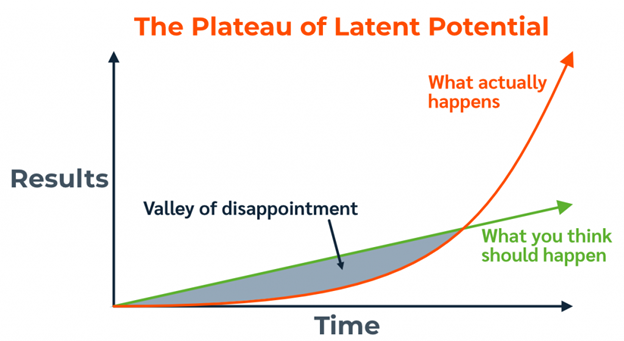Your Goals Set A Direction But Your Systems Lead To Progress
The Lazy Marathoner
A marathon is a race that psychopaths take part in. Globally, about 1.1 million people run a marathon each year, roughly .01% of the population.
This event is 26.2 miles from start to finish, roughly the distance from my house to downtown Milwaukee. Saying that doesn’t sound so crazy. However, breaking down the training is where things get nuts.
According to most sites (REI.com, Active.com, On-running.com, and many others), it takes 3-4 months of training to prepare for the marathon itself.
And most programs have a layout of 10-30+ miles/week, increasing total weekly mileage as you get closer to race day. Makes sense.
So, if you have an average pace per mile of 9 minutes, how many hours are you training over the 12-13 weeks?
9 min per mile x 300 miles (ish) = 2,700+ minutes
Two thousand seven hundred minutes = 45+ hours of running BEFORE you run a race that takes 4-5 hours to run.
That’s a ton of commitment, rest, and recovery!
And I’m betting you know someone who’s run a marathon. Are they still consistently running? Have they run a 2nd marathon? With an estimated 50% of all entrants being first-timers, I’m betting your friend checked the box and moved on.
But why would someone do that?
“If You Ain’t First, You’re Last.”
In his book, Atomic Habits, James Clear shows us how to start good habits and break bad ones. In chapter 1, he lays out four problems with setting goals:
- Winners and losers have the same goals
- Achieving a goal is only a momentary change
- Goals restrict your happiness
- Goals are at odds with long-term process
If goals are a problem, should we get rid of them entirely? No. “Goals are good for setting a direction, but systems are best for making progress.” p.23
Your friend most likely quit running because the goal was achieved. She wasn’t trying to become a runner; she wanted to complete a marathon. And there’s a huge difference.
I’ve done this so many times but wouldn’t have been able to articulate it. I love the feeling of accomplishing a goal, and it helped me win at some stuff along the way. “The idea is this: “Once I reach my goal, then I’ll be happy.” p.26
This super typical mentality doesn’t lead to consistent or lasting change; it leads to more and more short-term goals. And when you fall short, you’ve failed. There’s no middle ground. You either win, are successful, the best, or you’re a loser.
Trees & Ice Cubes
There’s a white pine tree in my backyard about eight years old and 25 ft. tall. When we moved into this house, it was about 4ft tall. When it was planted, it was 0 ft. tall. We didn’t notice that this tree was growing roughly 3ft a year, every year. That’s fast growth for a tree.
It was a little green stick with flimsy branches that couldn’t hold a squirrel. Now it’s a huge tree that I tell my kids to get out of when we’re running late for church.
“Imagine you have an ice cube sitting on the table in front of you. The room is cold, and you can see your breath. It is currently twenty-five degrees. Then, ever so slowly, the room begins to heat up.
Twenty-six degrees.
Twenty. Seven.
Twenty-eight.
The ice cube is still sitting on the table in front of you.
Twenty-nine degrees.
Thirty.
Thirty-one.
Still, nothing has happened.
Then, thirty-two degrees. The ice begins to melt. A one-degree shift seemingly no different from the temperature increases before it has unlocked a huge change.”
And here’s a statement that describes everyone you’ve ever thought of as an “overnight success.”
“Breakthrough moments are often the result of many previous actions, which build up potential required to unleash a major change.” p.20
That’s it!! Change doesn’t happen perfectly on time or consistently like that white pine. It breaks through like an ice cube in a thirty-two-degree room. But waiting sucks. It’s discouraging when I do a bunch of sit-ups every week for two months and don’t see a six-pack. I want success now. (Screw this program, it doesn’t work!)
James calls this principle the “Plateau of Latent Potential”. p.22


This graph is freeing.
What I think should happen = White Pine
What actually happens = Ice Cube
Valley of disappointment = “Screw this, nothing’s happening!”
Systems > Goals
We’re not scrapping goals. We’re mentally prepared for the “Valley of Disappointment.” Now what?
“Goals are about the results you want to achieve. Systems are about the processes that lead to those results.” p.23
Oh, snap! Stop freaking out about the ice being frozen, focus on turning the heat up one degree at a time. Small changes lead to big results.
Examples:
- “If you’re a coach, your goal might be to win a championship. Your system is the way you recruit players, manage your assistant coaches, and conduct practice.” p. 23
- “If you’re an entrepreneur, your goal might be to build a million-dollar business. Your system is how to test product ideas, hire employees, and run marketing campaigns.” p. 24
- If you’re a parent, your goal might be to help your son increase test scores. Your system is how you approach nightly homework, conversations about problem solving and making it rewarding or fun whenever possible. (Example from my life)
“Fix the inputs and the outputs will fix themselves.” p. 25
I encourage you to buy the book, go through it with your team at work, and most of all--put it into practice. Small efforts matter. Seemingly insignificant conversations build lasting relationships. Three minutes earlier a day makes you a morning person in a year. Consistently saying “thank you” over a decade grows a tree of gratitude inside your heart. It all matters.
“The purpose of setting goals is to win the game. The purpose of building systems is to continue playing the game. It’s not about a single accomplishment. It is about the cycle of endless refinement and continuous improvement. Ultimately, it is your commitment to the process that will determine your progress.” p. 27
Need more?
Check out the IOL Community Groups to connect with like-minded leaders!
Go to our YouTube and LinkedIn pages for more encouraging content.
If you’re looking to take your growth as a leader to the next level, we’ve got you covered. Join the Impact of Leadership Community today!




Comments